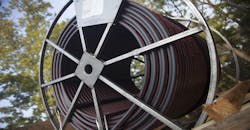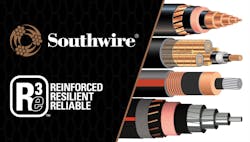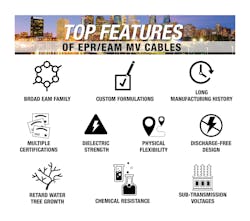Life Expectancy of TRXLP and EPR/EAM Insulated Cables
When extruded dielectric cables were first introduced in the 1960s and 1970s, the industry experts expected the cables to operate reliably for a minimum of 20 years. However, field records and experiences have proven otherwise. Corroded copper neutrals and dielectric breakdowns were identified as the chief root causes for premature cable failures.
The early dielectric breakdown of the insulation material can be attributed largely to impurities and imperfections in conductor shield, insulation, or the insulation shield layer. The high-stress materials, without an overall jacket, absorbed moisture and accelerated the proliferation of water trees, which were eventually converted into electrical trees. The combination of defects degraded the electrical properties so acutely that many cables failed within 5 to 10 years after energization.
Consequently, Water Tree-Retardant Crosslinked Polyethylene (WTR XLPE or TR-XLPE) and Discharge-Free Ethylene Propylene Rubber (EPR) insulation compounds were commercialized in the early 1980s and, at the same time, adding a cable jacket became a widely adopted practice. A protective jacket extends cable life not only by retarding the ingress of water containing ions from the ground but also by mitigating metallic shield corrosion.
The advancement in tree-retardant formulation, crosslinking chemistry, raw material cleanliness, enclosed compound handling equipment, and true-triple-extrusion equipment under dry nitrogen curing have improved the quality of power cables significantly in the past decades. These improved XLP or EPR insulated cables are now rapidly approaching 40-years of service. We recommend that when these aged cables are removed from the field for any reason that they are thoroughly inspected. These findings could determine the basis of failure and help to plan for future repairs or replacements.
Many end users specify both XLPE and EPR insulation materials for their medium-voltage cables. ASTM designates a nomenclature of Ethylene Alkene Copolymer or EAM where “E” indicates Ethylene, “A” denotes Alkene, and “M” describes the polymer’s repeating block. EAM classifies a comprehensive polymer chemical family with an Ethylene and an Alkene backbone. Ethylene Propylene Rubber (EPR) is a generic, and the most frequently used, terminology to describe a broad range of copolymers containing an Ethylene and a Propylene connecting unit.
There are a variety of EPR/EAM formulations that are commercially available and suitable for both low-voltage and medium-voltage cables. Many cable manufacturers, including Southwire, offer EPR/EAM medium voltage cables that meet or exceed all the industry requirements. The list of codes and standards include RUS (USDA’s Rural Utility Service), UL-1072 (Medium-Voltage Power Cables), AEIC CS8 (Extruded Dielectric, Shielded Power Cables Rated 5 Through 46 kV), ICEA S-94-649 (Concentric Neutral Cables Rated 5 Through 46 kV), CSA 68.10 (Shielded Power Cable for Commercial and Industrial Applications, 5-46 kV), and CSA 68.5 (Primary Shielded and Concentric Neutral Cable for Distribution Utilities).
Unlike TRXLPE, which is an unfilled insulating material, EPR/EAM materials are defined as filled formulations containing additives with a tailored concentration to achieve a synergistic property-performance relationship. Both leaded and no-lead insulations can be designed with any shielding types, water-swellable tapes, water-blocking powders, plus over 10 different jacketing materials to choose from. Both EPR/EAM and TRXLPE cables can achieve the maximum service life of 40 years and more. Applications expand from power generation, substations, renewables, data centers, and critical infrastructure projects such as mass transit and airports.
Sustainable All-in-One Cable-in-Conduit (CIC) Installation
Underground cables, rated 600 volts for secondary or rated 5-46 kV for primary, are often direct buried in a trench. Burying cables in earth, using either native soils or a thermal backfill, is common simply due to a shorter installation time and the initial cost savings. However, there is a growing trend in the industry to invest in an added protective barrier for the underground cables using conduits or pipes.
For example, pulling cables into a conduit encased in concrete can prevent cable damages and shield the energized lines from potential hazards resulting from near-by constructions. Accidental dig-ins can nick or rip out the jacket, neutrals, or the core of the cable very easily. In addition to the enhanced protection from the conduit, the biggest advantage is the convenience and the significant cost savings of future cable replacement due to upgrades or failures. Pulling old cables out from the conduit and pushing new cables in has proven to be much safer, more economical, and more efficient than a full excavation effort to locate and to dig out buried cables.
Instead of sourcing empty conduits and cables separately and then installing the conduit first by one crew followed by pulling in the cable potentially by a different crew, there is an alternative solution called CIC. Any type of underground cables can be pre-installed in a durable High-Density Polyethylene (HDPE) conduit to avoid pulling cables into a pipe on-site. This pre-assembled configuration, known as Cable-in-Conduit (CIC), has more than 30 years of user history with extensive uses in California.
It is manufactured by continuously extruding a crush and impact resistant HDPE conduit over a single cable or a parallel cable assembly. CIC might contain one cable or three-phase cables, but we have seen up to 4 cable components with a spare or an added equipment grounding conductor being designed using CIC. It is also common in the irrigation industry to use multiple control cables in CIC. For MV primary feeder systems with three-phase conductors, cables are laid in parallel within a conduit and are ready for single process on-site installation. The cables are pre-lubricated with a low friction pulling agent to prevent the cable insulation or jacket from adhering to the inside of the conduit wall and to aid in removal in the future.
HDPE-based resins meet all the applicable ASTM standards and CIC products are compliant with NEMA TC-7, UL-1990, UL-651 A, as well as the National Electrical Codes (NEC) for commercial, residential, and industrial applications. CIC is also gaining attention from the top investor-owned utilities (IOU) as well as Co-Ops and municipal utilities across the country. This sustainable all-in-one solution not only saves labor, shortens installation time, and reduces the total cost of the project, but most importantly the energized cables are enclosed within a ruggedized physical barrier before arriving to the field.
The non-metallic pipe is made of a high-density polyethylene compound which is hydrophobic in nature with a low degree of moisture absorption. HDPE exhibits a much slower moisture vapor transmission rate compared to that of PVC material and exceeds the environmental stress cracking resistance requirement per ASTM. Furthermore, HDPE features a superior thermal resistance and can withstand a relatively high temperature with minimum deformation and its high flexural modulus provides great strength upon bending.
PVC contains halogen, but HDPE is naturally halogen-free. Therefore, there is no risk with corrosive acid gas emission of hydrochloric acid using CIC made of HDPE before or during energization, which is one of the top environmental, health, and safety (EHS) considerations if there is a fire that consumes the conduit. The robust HDPE pipe is also flexible enough to be coiled onto a reel to maximize its shipping length. HDPE conduits can be produced with a continuous length over 10,000 feet depending on the trade sizes and the specific diameter.
HDPE pipes with enhanced mechanical, physical, thermal, moisture, and chemical properties minimize the impact from harsh environmental elements, accidental dig-ins, future utility repairs, or collapsing of structures above ground during severe weather events such as tornados, hurricanes, ice storms, or wildfires. Cable-in-Conduit is considered one of the fastest-growing undergrounding technologies to help deliver the next generation distribution grid.
It is not only a great privilege to be in the utility industry, but also a noble responsibility for all to continue to implement value-added innovations. What we have learned from the history and again through the recent major power outages is that safety and grid hardening will remain the foremost, non-negotiable objectives for all utility providers, regardless of the unique service territories, populations served, regulations, or policy mandates. Southwire Company is committed to responding, rectifying, and restoring the electrical grid by providing reinforced, resilient, and reliable products and solutions.
Sponsored by:






